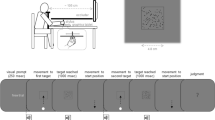Summary
Arm movements were studied in response to double-step stimuli in two-dimensional space. The inter-stimulus interval (ISI) between the two successive target presentations varied randomly between 25, 50, 75 and 100 ms. When ISI was 25 or 50 ms movement trajectories were sometimes modified by the second target already at the very onset of the movement. This modification was apparent from a change in the initial movement direction. A change in the initial movement direction occurred when the reaction time of the movement minus ISI was greater than 200 ms. The initial movement direction of these modified movements was in between the first and second target. To explain the results we conclude that 1) the internal representation of target position shifts gradually to its final position and 2) the motor programme uses as the goal of the movement this current internal representation that may not yet have reached that final position.
Similar content being viewed by others
References
Becker W, Jürgens R (1979) An analysis of the saccadic system by means of double step stimuli. Vision Res 19: 967–983
Craven P, Wahba G (1979) Smoothing noisy data with spline functions. Numer Math 31: 377–403
Georgopoulos AP, Kalaska JF, Massey JT (1981) Spatial trajectories and reaction times of aimed movements: effects of practice, uncertainty, and change in target location. J Neurophysiol 46: 725–743
Gielen CCAM, Heuvel PJM van den, Gisbergen JAM van (1984a) Coordination of fast eye and arm movements in a tracking task. Exp Brain Res 56: 154–161
Gielen CCAM, Heuvel PJM van den, Denier van der Gon JJ (1984b) Modification of muscle activation patterns during fast goal-directed arm movements. J Motor Behav 16: 2–19
Gisbergen J van, Gielen S, Cox H, Bruijns J, Kleine Schaars H (1981) Relation between metrics of saccades and stimulus trajectory in visual target tracking; implications for models of the saccadic system. In: Fuchs A, Becker W (eds) Progress in oculomotor research. Elsevier, New York, pp 19–27
Gottsdanker R (1973) Psychological refractoriness and the organization of step-tracking responses. Percept Psychophys 14: 60–70
Keele SW (1981) Behavioral analysis of movement. In: Brooks VB (ed) Handbook of physiology, the nervous system. Vol II. Motor control, Part 2. Am Physiol Society, Bethesda, Md, pp 1391–1414
Lisberger SG, Fuchs AF, King WM, Evinger LC (1975) Effects of mean reaction time on saccadic responses to two-step stimuli with horizontal and vertical components. Vision Res 15: 1021–1025
Marsden CD, Rothwell JC, Day BL (1984) The use of peripheral feedback in the control of movement. Trends Neurosci 7: 253–257
Megaw ED (1974) Possible modification to a rapid on-going programmed manual response. Brain Res 71: 425–441
Sanes JN, Jennings VA (1984) Centrally programmed patterns of muscle activity in voluntary motor behavior of humans. Exp Brain Res 54: 23–32
Schmidt RA (1982) Motor control and learning, a behavioral emphasis. Human Kinetics Publishers, Champaign, Ill
Smith WM, Bowen KF (1980) The effects of delayed and displaced visual feedback on motor control. J Motor Behav 12: 91–101
Soechting JF, Lacquaniti F (1983) Modification of trajectory of a pointing movement in response to a change in target location. J Neurophysiol 49: 548–564
Wadman WJ, Denier van der Gon JJ, Geuze RH, Mol CR (1979) Control of fast goal-directed arm movements. J Human Move Stud 5: 3–17
Wadman WJ, Denier van der Gon JJ, Derksen RJA (1980) Muscle activation patterns for fast goal-directed arm movements. J Human Move Stud 6: 19–37
Woltring HJ (1986) A fortran package for generalized, crossvalidatory spline smoothing and differentiating. Adv Eng Software 8: 104–113
Author information
Authors and Affiliations
Rights and permissions
About this article
Cite this article
van Sonderen, J.F., Denier van der Gon, J.J. & Gielen, C.C.A.M. Conditions determining early modification of motor programmes in response to changes in target location. Exp Brain Res 71, 320–328 (1988). https://doi.org/10.1007/BF00247492
Received:
Accepted:
Issue Date:
DOI: https://doi.org/10.1007/BF00247492




